Dry needling
Dry needling is a technique used for the treatment of pain and movement impairments.
The technique uses a "dry"needle, one without medication or injection, inserted through the skin into areas of the muscle.
Dry needling is not acupuncture, a practice based on traditional Chinese medicine and performed by acupuncturists.
What’s the difference?:
Dry Needling: Focuses on subjective and objective examination of the neuromuscular systems to find “trigger points” and needle insertion points are based on knowledge of neuroanatomy.
Acupuncturists: Use needles to balance energy, life force and qi in the body based on knowledge of body meridians.
WHAT IS A TRIGGER POINT?
A trigger point is a taut band of skeletal muscle located within a larger muscle group. Trigger points can be tender to the touch, and touching a trigger point may cause pain to other parts of the body (referred pain).
WHAT KIND OF NEEDLES ARE USED?
Dry needling involves a thin filiform needle that penetrates the skin and stimulates underlying myofascial trigger points and muscular and connective tissues. The needle allows a physical therapist to target tissues that are not manually palpable.
WHY DRY NEEDLING?
In cases when dry needling is used by physical therapists, it is typically 1 technique that's part of a larger treatment plan.
Physical therapists use dry needling with the goal of releasing or inactivating trigger points to relieve pain or improve range of motion. Preliminary research 2 supports that dry needling improves pain control, reduces muscle tension, and normalizes dysfunctions of the motor end plates, the sites at which nerve impulses are transmitted to muscles. This can help speed up the patient's return to active rehabilitation.
BENEFITS OF DRY NEEDLING:
Physiologic Effects of dry Needling:
Increase blood flow to the area
Aides in healing tissue
Decrease Banding
Restores muscle length and normalize muscle length tension relationship. This allows muscles to be in the right length to do their best/ strongest work.
Decrease Spontaneous Electrical Activity
Decrease in the “muscle spasm” allowing muscle to release tension
Biomechanical Changes
Decrease nociceptive (pain) sensitizing agents
Increase in beta-endorphin levels (Has an anesthetic effect)
Central Nervous system changes
Drives gate control theory
Has an influence on the inflammatory and healing processes
Book Now
All patients MUST be seen for a Physical Therapy Evaluation before scheduling an individual treatment or wellness visit. If deemed appropriate, dry needling is often performed during: evaluation, follow-up treatment and/or a wellness visit.





